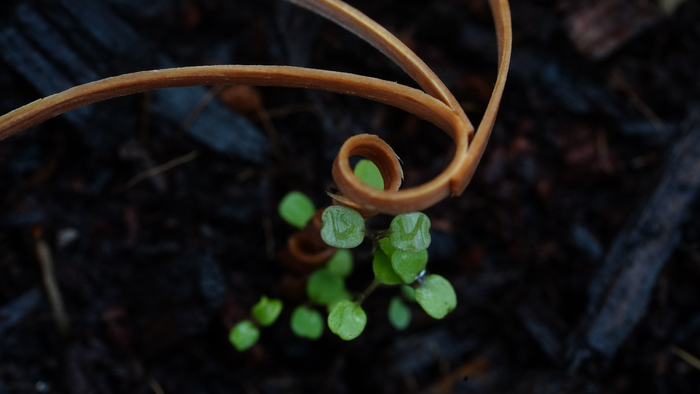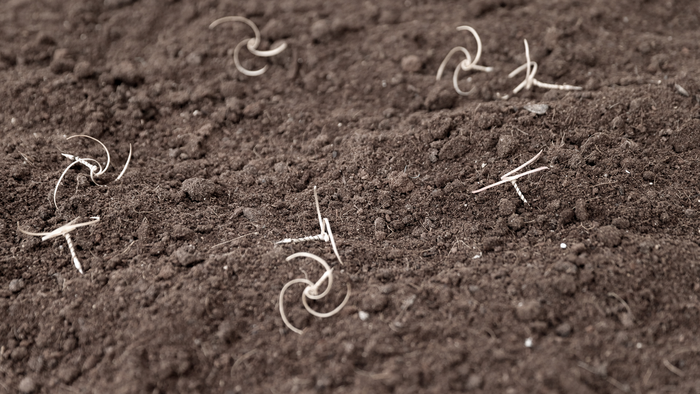A New Twist On Sowing Seeds
8:27 minutes

Imagine sowing a handful of seeds on the ground—but instead of needing planting help from a rake or hoe, the seeds can determine for themselves when the ground is fresh from the rain and ready for planting, and burrow their own way into the damp soil.
Some seeds, including varieties of Erodium species, can actually do that. They use their self-burying ability to adapt to arid climates. But in a recent study in the journal Nature, researchers describe a package, or wrapper that can give other kinds of seeds self-burying powers as well. The design adapts some of the shapes and techniques used by Erodium into a biodegradable corkscrew made of engineered wood, that can respond to moisture and uncoil to slowly drill a seed into receptive soil.
Dr. Lining Yao, co-author of that report and director of the Morphing Matter Lab in Carnegie Mellon’s School of Computer Science, joins guest host Regina Barber to describe the seed delivery system, and what remains to be solved before it can be used in the wild.

Lining Yao is an assistant professor and director of the Morphing Matter Lab in the School of Computer Science at Carnegie Mellon University in Pittsburgh, Pennsylvania.
REGINA BARBER: This is Science Friday, I’m Regina Barber. Maybe you’re looking ahead to spring planting. Imagine sowing a handful of seeds on the ground, seeds that can determine for themselves when the ground is ready for planting, fresh from the rain, and can burrow their own way into the damp soil. Some seeds can in fact do that themselves and use that ability to adapt to arid climates. But in a recent study in the journal Nature, researchers describe a package or wrapper that can give other kinds of seeds self-burying powers via a biodegradable corkscrew made of engineered wood. Dr. Lining Yao is director of the Morphing Matter Lab in the Carnegie Mellon School of Computer Science, and co-author of that report. Welcome back to Science Friday, Dr. Yao.
LINING YAO: Thank you for having me.
REGINA BARBER: Listeners can see pictures of this device on our website, but can you describe what this seed wrapper looks like for us.
LINING YAO: So we designed this three-tailed self-burying seed carrier. The system is made up of three parts, the seed pod and at very bottom, it looks pointy, and also a coiled body and a long tail. So when rain comes, the coil body will loosen itself. And that will cause a spinning motion of the seed system and eventually have it drill into the ground by itself.
REGINA BARBER: And the top these tails kind of look like a pinwheel on on top of a stick.
LINING YAO: Exactly. Especially if you have the three tailed version, it really looks like a pinwheel. And the three tails are designed for their specific purpose. It helped the seed to establish itself in a specific pose that’s easier to initiate the drilling.
REGINA BARBER: So this corkscrew shape or this top that kind of looks like a helicopter, it’s not the whole story. How do you engineer it to physically burrow into the ground.
LINING YAO: This is inspired by how the natural seeds, a natural grass species called Erodium seeds can self bury into the ground. So in the lab, we basically studied how the natural seed works in this way, and figured out a engineering solution to have the self burial behavior. And we can actually now have our system drill even faster and more effective than the natural competitors, per se.
REGINA BARBER: So how quickly does it spin into the ground?
LINING YAO: It’s not very fast, you know, it’s a passive system. So that wood has to be wettened first by the rain or rise of the humidity in the atmosphere. And gradually as the water molecules penetrate in and swell, the matrices of the cellulose construct, the coil will start to loosen itself.
REGINA BARBER: When you say it responds to moisture is it like when my hair responds to humidity, it gets curlier. Is it kind of like that?
LINING YAO: Both hairs and also the wood materials we use, as well as the materials that are used for natural self bearing seeds, are hydromorphic. So this is a term basically it means responsive to water molecules in the environment and transform. So the idea is we can attract water and expand along a certain direction. And in our seed, the expansion will cause the loosening of the coil and the transformation of the whole body. And then allow the motion of drilling.
REGINA BARBER: Why do you think we need this now? Like, what is the use of these seeds?
LINING YAO: So we looked into the apparent practice of aerial delivery of seeds. Basically using airplanes or drones to drop seeds from the above. This is already a common practice in agriculture and also in reforestation, when you have to deploy seeds to a massive area in a short time period or when those places are hard to reach. But there are obstacles. So when you drop the seeds from the sky, you don’t bury them and they ended up getting blown away by strong wind or eaten by the birds. So then we got inspired by how nature sees you conquer those obstacles, right? They drop on the floor, they self bury. So we wanted to give a more of a physical replica to allow our carrier to basically embody different seeds that are needed for environmental conservation, for agriculture, but also have improved germination rate compared to the currencies dropped from the sky.
REGINA BARBER: Are these sea packages, can they be mass produced? Like, how are they made?
LINING YAO: So right now we only have smaller scale manufacturing strategy in the lab. It’s basically made of two critical steps. One is a chemical washing process to make the wood more compliant. If you think about wood is actually kind of brittle, but in order to turn it into a very large curvature, basically very tight coil, you need it to be a bit more compliant. So that’s the chemical washing process. And then next, we will follow by a molding process manually winding the flat wood stripes into the coiled body. It sounds very simple. Indeed, it’s not complicated. But still there will be some more efforts needed to make it mass producible in a factory. Also, cheaply, hopefully.
REGINA BARBER: Have you and your grad students gotten very good at this?
LINING YAO: We are getting definitely very good at it through the, you know, through the years. So we had to basically fabricate more than 200 seeds, each with three tails for outdoor tests. And through this process we’re getting more and more precise making exactly the identical geometries.
REGINA BARBER: Have you worked on any other shapes or types of seed wrappers?
LINING YAO: Along with the idea of self bearing seeds, we actually explored, for example, different sizes, different numbers of tails. And we are interested in different sizes because we’re interested in using it to carry different things. So for example, burying a very small vegetable seeds need only a very small carrier to save material. But if you want to use it to deploy whitebark pine seeds for reforestation purpose, then you need much larger body. And we’re interested in whitebark pine because that is commonly used for reforestation in North America.
REGINA BARBER: Can you use this for more than just seeds?
LINING YAO: That’s also a really good question. So obviously, you can chemically wash the wood and mold it into other shapes rather than the coil or the tail, and they’re gonna be moisture responsive, they’re gonna be biodegradable. So in that sense, you can imagine using these for, yeah, water fluctuation based energy harvesting in the wild. You can also think about making biodegradable robots that responds to rain or day and night moisture fluctuations in the environment. Lots of possible use cases there. Yeah. All exciting to us.
REGINA BARBER: I am so excited for these biodegradable robots. I’m a little sad, though, that if they they biodegrade. So where do you go from here? Like what’s the next big step beyond solving the mass production problem?
LINING YAO: We really hope to be able to learn more from domain experts. So we’re talking about farmers or ecologists and people who are, you know, right now doing actual jobs for reforestation, or environmental conservation, because none of us are really professional in those fields and anything we put into nature are serious. We don’t want to accidentally cause more harm. We know that they are good for germination, but not necessarily compatible with the local environment or ecological conditions. So yeah, basically getting more engaged in those conversations with domain experts for possibly larger pilot tests are very exciting to us.
REGINA BARBER: Dr. Lining Yao is director of the Morphine Matter Lab in Carnegie Mellon School of Computer Science in Pittsburgh. Thanks for taking the time to talk to me today. I really appreciate it.
LINING YAO: Thank you for having me. It’s a great honor to be here.
Copyright © 2023 Science Friday Initiative. All rights reserved. Science Friday transcripts are produced on a tight deadline by 3Play Media. Fidelity to the original aired/published audio or video file might vary, and text might be updated or amended in the future. For the authoritative record of Science Friday’s programming, please visit the original aired/published recording. For terms of use and more information, visit our policies pages at http://www.sciencefriday.com/about/policies/
As Science Friday’s director and senior producer, Charles Bergquist channels the chaos of a live production studio into something sounding like a radio program. Favorite topics include planetary sciences, chemistry, materials, and shiny things with blinking lights.
Regina G. Barber is a scientist in residence at Short Wave, from NPR.